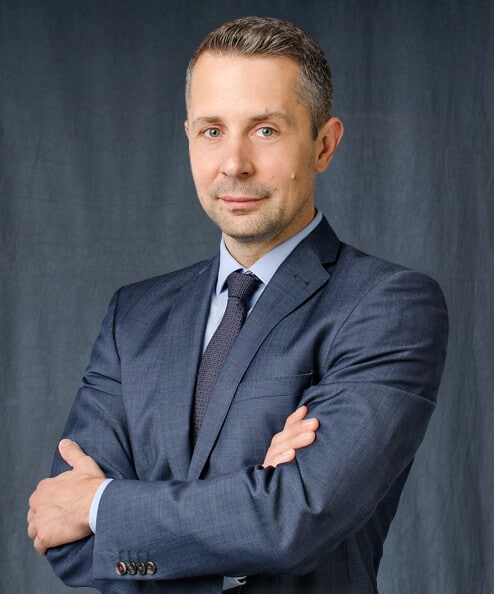Professional burnout, and what to do about it, “biz.liga.net”
Kiev, Ukraine – How do you prevent your dream job from turning into the worst mistake of your life? Most career professionals go through periods of self-reflection and search for meaning – a phenomenon known as burnout. “It is common for professionals to seek a new job in a fresh domain, and for different reasons. The majority of them do not understand that they’re experiencing burnout, and they start looking for external reasons. The main factors pushing workers to radically change their life and career vector include dissatisfaction with their chosen profession, financial issues and lack of career growth,” says Vladimir Kolomoets, Country Manager for Ukraine at Pedersen & Partners.

“Many people believe that transition to another professional sphere will help them to move their career out of this deadlock. Some want to get a broader perspective, as bankers here in Ukraine have been doing for the last five years. Some just want to try to escape from their reputation, and think this will be easier in a new place where nobody knows them yet. Others are trying to run from a scandalous situation, although they will try to conceal this, of course. It’s very difficult to change your field in Ukraine – employers are prejudiced and believe that such transfers are rarely successful,” Vladimir adds.
Professional burnout isn’t rare in the corporate world, even at the highest levels. At one time, Apple’s legendary CEO Steve Jobs, left the company to spend seven months in India.
LIGA.net asked several business leaders and public officials whether they have ever experienced professional burnout, what the main causes are, and how to deal with it.
David Braun, CEO & co-founder of TemplateMonster
Have I had a professional burnout in the last 15 years? Of course! In fact, I would be very surprised to meet anyone who has been working in the same company for more than five years without at least one burnout.
It would be so much easier if we were all able to spot burnout symptoms at an early stage, but this comes with experience. As soon as you start to feel like a robot doing the same thing every day – remember the film Groundhog Day, when the passing days turn to weeks, and the weeks turn to months – beware, because burnout is close.
In order to avoid pouring out my grumpiness onto others, I apply several tricks.
Horrible weekends. Find the work you despise most of all, and dedicate a whole weekend to it, to get you out of your comfort zone. For example, I hate working with large tables and numbers, but I love people. After two days working with financial documents, I am delighted to return to working with people, and I’m ready to give them a big hug on Monday morning!
The kick. Burnout often comes from achieving a high level of proficiency when you do everything automatically and you feel as if you’ve maxed out your skills. In this case, a good exercise would be to watch videos from the industry’s experts, and perhaps meet with a more skilful expert in the field. This will keep you honest and make you aware of a whole range of things you’re not acquainted with yet, motivating you to constantly develop yourself.
Major refocus. If these life hacks do not work, you may have a serious problem. Before giving up and changing jobs, you should try a third tactic. Talk with your manager and try to dramatically change the focus of your work. Take on a new project, join a new team, challenge yourself and master a whole new area. As a rule, this should invigorate you to work again at full strength.
Maxim Belyavsky, adviser to Ukraine’s Minister of Energy and the Coal Industry
How to prevent professional burnout? In order to answer this question, it is important to first understand that a profession is a journey. During this period of time, we overcome obstacles at different levels, we meet like-minded people and opponents, we learn and we teach others in turn.
Professional growth can be compared with the progress of a car along the highway. If an overworked driver does not stop to rest in good time, there is a risk of falling asleep behind the wheel. Similarly, if you do not notice the first signs of professional burnout in time, you may never achieve your dream. But how can you recognise the symptoms?
The main sign is a lack of interest – there is no development of thought. If you start to notice any inertia of processes at work paired with a lack of career prospects, the next stage is a loss of interest in your immediate duties at work, and emotional irritability when you are in the office. The apex of professional burnout is an internal sensation of total collapse, accompanied by irritability and a distorted perception of reality.
What should you do?
First, you should maintain faith in your professional future. The best way to do this is to draw up an indicative strategic plan for your own development: the goal, the means, and the benchmarks for implementing the plan.
Secondly, you should start perceiving professional activities as thought they were sports competitions. Your rivals are your competitors, and 70% of them will be stronger than you. Your main task is victory, and to achieve it you need to develop your professionalism. In this regard, you must consider work as a daily gym workout for your brain, while at the same time maintaining a balance between work and pleasure. This will help you generate new ideas and projects that will lead you to Olympic victory.
If you are unable to develop any new ideas or projects, you should switch to another job or arrange a short-term break, which will only be effective if you completely disconnect from business.
Finally, do not be afraid to face challenges and changes. You cannot become a real professional in optimum greenhouse conditions – you need the cold winds and the droughts to toughen you up. Extreme situations force us to analyse blunders and mistakes, and quickly find the way out of the situation – there is always a solution!
Ilya Filipov, CEO of EdEra, online training platform
I have been leading the EdEra studio team for the last three and a half years. We created this project from scratch, and for the first two years, I was hardly ever distracted from our workflow. Despite such a challenging schedule, I cannot remember any extended periods of burnout. To me, the process is a repeating sinusoid curve: one day you are sure that everything is lost, the next day you feel a burst of energy and confidence that you can do anything.
One of the main signs of burnout that I have noticed in myself is apathy and an indifference to the value of certain processes, as well as uncertainty about the rightness of my own path and abilities.
When these periods come, it’s very important the team supports you, as they can see things from a different perspective and easily explain that in fact your perception of the world is not justified. My feeling is that a positive climate in the team, with trust and the ability to communicate openly, is the most efficient remedy for professional burnout.
Another important motivating factor is the feeling of continuous development. No wonder that people become immersed in video games and cannot tear themselves away.
The gamification principle is that each new task should be more complicated than the previous one – enough for a challenge, but not enough that repeated failure will demotivate the player. Maintaining this fine line in setting tasks for yourself and your team can significantly reduce the risk of burnout. I even have a rule – if some task scares me with its complexity and I want to abandon it, it is essential that I do it. This provides me with new challenges and an increase to self-esteem.
On the whole, my recipe for avoiding burnout comes in three parts. Firstly, build trust in a professional team so that you do not have to keep all problems to yourself. Secondly, challenge yourself and evolve so that you do not feel stale. And finally, sometimes rest, putting work completely out of your head.
Adapted from: http://biz.liga.net/hr/all/stati/3707815-kakovy-simptomy-prfessionalnogo-vygoraniya-i-kak-s-nim-borotsya.htm
 Vladimir Kolomoets is a Client Partner and the Country Manager for Ukraine at Pedersen & Partners. Mr. Kolomoets has more than 15 years of extensive experience in the field, with over 300 Executive Search and recruitment assignments across all practice groups. He puts a particular emphasis on the Industrial (Heavy Industry, Mining, Metallurgy, Agribusiness), Telecommunications, Technology, and Consumer Products sectors across the CIS region. Prior to re-joining the firm, Mr. Kolomoets held senior roles with two international Executive Search firms in which he served as Partner and Client Manager.
Vladimir Kolomoets is a Client Partner and the Country Manager for Ukraine at Pedersen & Partners. Mr. Kolomoets has more than 15 years of extensive experience in the field, with over 300 Executive Search and recruitment assignments across all practice groups. He puts a particular emphasis on the Industrial (Heavy Industry, Mining, Metallurgy, Agribusiness), Telecommunications, Technology, and Consumer Products sectors across the CIS region. Prior to re-joining the firm, Mr. Kolomoets held senior roles with two international Executive Search firms in which he served as Partner and Client Manager.
Pedersen & Partners is a leading international Executive Search firm. We operate 56 wholly owned offices in 52 countries across Europe, the Middle East, Africa, Asia & the Americas. Our values Trust, Relationship and Professionalism apply to our interaction with clients as well as executives. More information about Pedersen & Partners is available at www.pedersenandpartners.com
If you would like to conduct an interview with a representative of Pedersen & Partners, or have other media-related requests, please contact: Diana Danu, Marketing and Communications Manager at: diana.danu@pedersenandpartners.com
